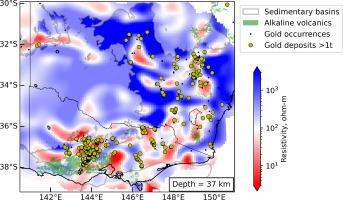当前位置:
X-MOL 学术
›
Tectonophysics
›
论文详情
Our official English website, www.x-mol.net, welcomes your feedback! (Note: you will need to create a separate account there.)
Lithospheric architecture of a Phanerozoic orogen from magnetotellurics: AusLAMP in the Tasmanides, southeast Australia
Tectonophysics ( IF 2.9 ) Pub Date : 2020-10-01 , DOI: 10.1016/j.tecto.2020.228560 Alison Louise Kirkby , Robert J. Musgrave , Karol Czarnota , Michael P. Doublier , Jingming Duan , Ross A. Cayley , Darren Kyi
Tectonophysics ( IF 2.9 ) Pub Date : 2020-10-01 , DOI: 10.1016/j.tecto.2020.228560 Alison Louise Kirkby , Robert J. Musgrave , Karol Czarnota , Michael P. Doublier , Jingming Duan , Ross A. Cayley , Darren Kyi

|
Abstract We present a resistivity model of the southern Tasmanides of southeastern Australia using Australian Lithospheric Architecture Magnetotelluric Project (AusLAMP) data. Modelled lower crustal conductivity anomalies resemble concentric geometries revealed in the upper crust by potential field and passive seismic data. These geometries are a key part of crustal architecture predicted by the Lachlan Orocline model for the evolution of the southern Tasmanides, in which the proterozoic Selwyn Block drives oroclinal rotation against the eastern Gondwana margin during the Ordovician period. For the first time, we image these structures in three dimensions (3D) and show they persist below the Moho. These include a lower crustal conductor largely following the northern Selwyn Block margin. Spatial association between lower crustal conductors and both Paleozoic to Cenozoic mafic to intermediate alkaline volcanism and gold deposits suggests a genetic association i.e. fluid flow into the lower crust resulting in the deposition of conductive phases such as hydrogen, iron, sulphides and/or graphite. The 3D model resolves a different pattern of conductors in the lithospheric mantle, including northeast trending anomalies in the northern part of the model. Three of these conductors correspond to Cenozoic leucitite volcanoes along the Cosgrove mantle hotspot track which likely map the metasomatised mantle source region of these volcanoes. The northeasterly alignment of the conductors correlates with variations in the lithosphere-asthenosphere boundary (LAB) and the direction of Australian plate movement, and may be related to movement of an irregular LAB topography over the asthenosphere. By revealing the tectonic architecture of a Phanerozoic orogen and the overprint of more recent tectono-magmatic events, our resistivity model enhances our understanding of the lithospheric architecture and geodynamic processes in southeast Australia, demonstrating the ability of magnetotelluric data to image geological processes over time.
中文翻译:

来自大地电磁学的显生宙造山带岩石圈结构:澳大利亚东南部塔斯马尼德的 AusLAMP
摘要 我们使用澳大利亚岩石圈结构大地电磁项目 (AusLAMP) 数据提出了澳大利亚东南部塔斯曼尼德南部的电阻率模型。模拟的下地壳电导率异常类似于势场和被动地震数据在上地壳中揭示的同心几何形状。这些几何形状是 Lachlan Orocline 模型预测的塔斯马尼德南部演化的地壳结构的关键部分,其中元古界 Selwyn 地块在奥陶纪期间推动了相对于冈瓦纳大陆东部边缘的口斜旋转。我们第一次在三个维度 (3D) 中对这些结构进行成像,并显示它们在莫霍面下方持续存在。这些包括一个主要沿着塞尔温块北部边缘的下地壳导体。下地壳导体与古生代至新生代基性火山作用和中碱性火山作用和金矿床之间的空间关联表明存在遗传关联,即流体流入下地壳导致导电相如氢、铁、硫化物和/或石墨的沉积。3D 模型解析了岩石圈地幔中不同的导体模式,包括模型北部的东北向异常。其中三个导体对应于沿着科斯格罗夫地幔热点轨道的新生代白榴石火山,这可能映射了这些火山的交代地幔源区。导体的东北方向与岩石圈-软流圈边界 (LAB) 的变化和澳大利亚板块运动的方向有关,并且可能与不规则 LAB 地形在软流圈上的运动有关。通过揭示显生宙造山带的构造结构和最近构造岩浆事件的叠加,我们的电阻率模型增强了我们对澳大利亚东南部岩石圈结构和地球动力学过程的理解,展示了大地电磁数据对地质过程随时间成像的能力。
更新日期:2020-10-01
中文翻译:

来自大地电磁学的显生宙造山带岩石圈结构:澳大利亚东南部塔斯马尼德的 AusLAMP
摘要 我们使用澳大利亚岩石圈结构大地电磁项目 (AusLAMP) 数据提出了澳大利亚东南部塔斯曼尼德南部的电阻率模型。模拟的下地壳电导率异常类似于势场和被动地震数据在上地壳中揭示的同心几何形状。这些几何形状是 Lachlan Orocline 模型预测的塔斯马尼德南部演化的地壳结构的关键部分,其中元古界 Selwyn 地块在奥陶纪期间推动了相对于冈瓦纳大陆东部边缘的口斜旋转。我们第一次在三个维度 (3D) 中对这些结构进行成像,并显示它们在莫霍面下方持续存在。这些包括一个主要沿着塞尔温块北部边缘的下地壳导体。下地壳导体与古生代至新生代基性火山作用和中碱性火山作用和金矿床之间的空间关联表明存在遗传关联,即流体流入下地壳导致导电相如氢、铁、硫化物和/或石墨的沉积。3D 模型解析了岩石圈地幔中不同的导体模式,包括模型北部的东北向异常。其中三个导体对应于沿着科斯格罗夫地幔热点轨道的新生代白榴石火山,这可能映射了这些火山的交代地幔源区。导体的东北方向与岩石圈-软流圈边界 (LAB) 的变化和澳大利亚板块运动的方向有关,并且可能与不规则 LAB 地形在软流圈上的运动有关。通过揭示显生宙造山带的构造结构和最近构造岩浆事件的叠加,我们的电阻率模型增强了我们对澳大利亚东南部岩石圈结构和地球动力学过程的理解,展示了大地电磁数据对地质过程随时间成像的能力。


























 京公网安备 11010802027423号
京公网安备 11010802027423号